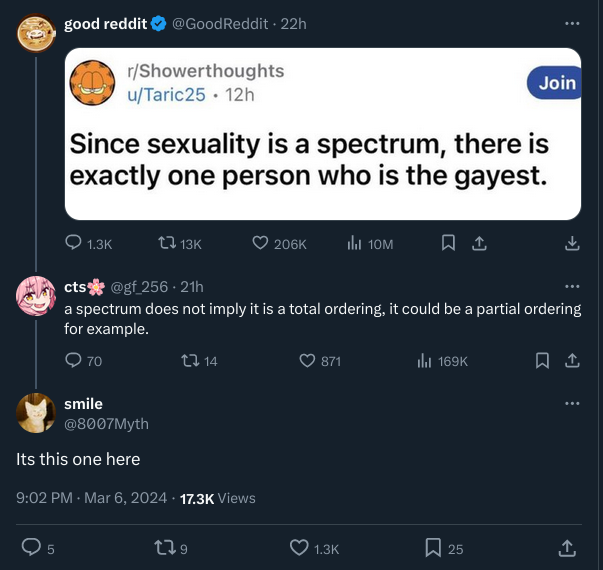Based anime set theorist.
196
Be sure to follow the rule before you head out.
Rule: You must post before you leave.
There can be only one!
a consequence of the axiom of choice is that every set can be given a well ordering. and well orderings always have smallest elements, but they may not have largest elements.
so there is someone who is the least gay, but there may not be a single person who is the most gay.
The axiom of choice doesn't say one way or another whether the spectrum in "the standard order" (is there a standard definition of more/less gay?) is a well ordering, only that there is some well ordering.
The axiom of choice allows to duplicate a sphere...
I know mathematicians tend to approve of it, but the naturalist in me knows it's bullshit.
you could think about it this way: one sphere and two spheres have the same “number” of points. (in the same way that there are just as many real numbers as there are real numbers in the interval (0,1).)
so, it becomes “”plausible”” that you could use one sphere to construct two spheres (because in some sense, you aren’t “adding any new points”).
but in the real world, “spheres” only have a finite number of atoms. so if we regard atoms as “points”, then it’s no longer true that one sphere and two spheres have the same number of “points”. and in some sense, this is why the sphere duplication trick doesn’t work in the real world.
it’s also worth mentioning that you have to do some pretty fucked up and unusual things in order to actually duplicate the sphere, and if you don’t allow such weird things to be done to the sphere, then it’s no longer possible to duplicate it, even with the axiom of choice.
By performing measure-preserving transformations to non-measurable sets and acting surprised when at the end of the day measure isn't preserved. I don't blame AC for that. AC only implies the existence of a non-measurable set, which is in itself not totally counter-intuitive.
Yeah, I'm really out of my element talking about these abstract mathematical topics... I'm too much of an empirical scientist it seems!
Give me a set and I'll find a way to measure it! ...actually I'd like to know what's the mathematical definition of measurement, there's probably a trick there... 🤔
Measure theory gets pretty abstract, so I recommend using a source thats not me. For the Real Numbers, the standard measure (usually the Lebesgue measure) is a way to generalize notions of lengths of intervals to sets that are not intervals or easy unions of intervals. For any set E, we can find various sequences of open intervals (potentially infinitely many intervals) whose union will contain E. The Lebesgue outer measure of E is defined as the infimum of the sum of the lengths of those sequences of intervals (infimum is similar to minimum except that an infimum may not actually be attained). The set E is considered Lebesgue measurable if it satisfies am additional criterion (Caratheodory criterion) in which case the Lebesgue measure is equal to the Lebesgue outer measure. If E does not satisfy that criterion, then it is non-measurable. A measure has desirable certain properties that an outer measure does not satisfy, which is why we prefer the former. Apologies to all math people for any inaccuracies in the above description, it's been a while.
"Measure" is meant in the specific sense of measure theory. The prototypical example is the Lebesgue measure, which generalizes the intuitive definition of length, area, volume, etc. to N-dimensional space.
As a pseudo definition, we may assume:
-
The measure of a rectangle is its length times its width.
-
The measure of the disjoint union of two sets is the sum of their measures.
In 2), we can relax the assumption that the two sets are disjoint slightly, as long as the overlap is small (e.g. two rectangles overlapping on an edge). This suggests a definition for the measure of any set: cover it with rectangles and sum their areas. For most sets, the cover will not be exact, i.e. some rectangles will lie partially outside the set, but these inexact covers can always be refined by subdividing the overhanging rectangles. The (Lebesgue) measure of a set is then defined as the greatest lower bound of all possible such approximations by rectangles.
There are 2 edge cases that quickly arise with this definition. One is the case of zero measure: naturally, a finite set of points has measure zero, since you can cover each point with a rectangle of arbitrarily small area, hence the greatest lower bound is 0. One can cover any countably infinite set with rectangles of area epsilon/n^(2) so that the sum can be made arbitrarily small, too. Even less intuitively, an uncountably infinite and topologically dense set of points can have measure 0 too, e.g. the Cantor set.
The other edge case is the unmeasurable set. Above, I mentioned a subdivision process and defined the measure as the limit of that process. I took for granted that the limit exists. Indeed, it is hard to imagine otherwise, and that is precisely because under reasonably intuitive axioms (ZF + dependent choice) it is consistent to assume the limit always exists. If you take the full axiom of choice, you may "construct" a counterexample, e.g. the Vitali set. The necessity of the axiom of choice in defining this set ensures that it is difficult to gain any geometric intuition about it. Suffice it to say that the set is both too "substantial" to have measure 0, yet too "fragmented" to have any positive measure, and is therefore not well behaved enough to have a measure at all.
